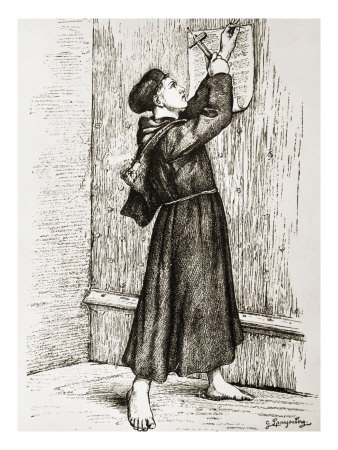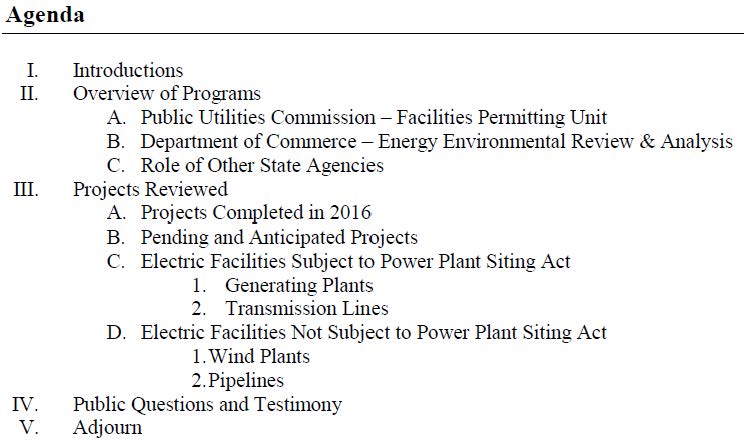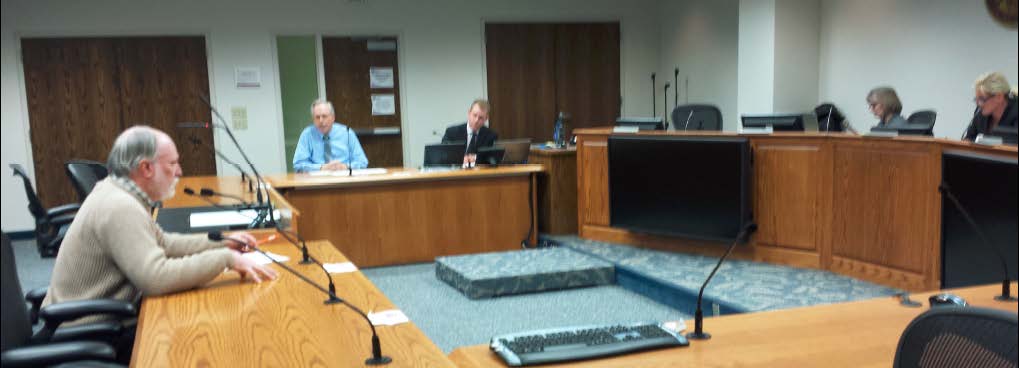2016 PPSA Annual Hearing
December 23rd, 2016
Tuesday was the Annual Hearing for the Power Plant Siting Act. I’ve been fighting off this sickness that Alan’s had for a week now, and not quite feeling right, more like life inside a pillow, everything’s rather dampened. But I slogged out into the world, and raised a few of the recurring points, issues with the Power Plant Siting Act, particularly public participation issues common not just to the Power Plant Siting Act (Minn. Stat. Ch. 216E ), but also to wind siting dockets under Minn. St. Ch. 216F, and pipeline routing dockets under Minn. St. Ch. 216G.
Here’s how to submit comments, deadline January 20, 2017:
Until this year, the Power Plant Siting Act Annual Hearing has included a review, rundown, listing, of all the projects approved by the Commission, including wind and pipelines, and this was anticipated at this hearing per the notice:
The full Notice:
HOWEVER… that report, “Projects Reviewed” section D, “Electric Facilities Not Subject to Power Plant Siting Act, did not occur. I’d guess in large part it was due to the many issues raised by those intervening and participating, or attempting to participate, in wind siting dockets who have appeared at PPSA Annual Hearings over the years. And I’m sure they did not want input from those participating and intervening in pipeline dockets, we’ve seen how Enbridge cancelled their “public informational meetings” up north after having to face the public and their legitimate issues the day before in Bemidji. Alan Mitchell, formerly EQB PPSA staff, and now working for Enbridge, was there, so this was on Enbridge’s radar, but of course, that Alan didn’t have any comments for the record (I do wish I remembered more about the pipeline rules rewrite that he worked on during his time at the EQB, I think somewhere around 2002-2004?).
The ALJ is to write a summary of the Comments, both at the meeting, and those filed afterwards, and then? What happens? Experience says “not much.” PUC staff responded to the “What happens” question saying that things that don’t require statutory changes or rulemaking, that those are things they want to impliment, to change, to improve, and to the extend that we can, we implement. So he said. When the report comes from the ALJ, they review it, they’ll have the transcript from this meeting, and will go over it.
There was a pretty crowded room, better attendance than for the last couple of years, with two new members of the public speaking up. John Munter, who has been very active in opposition to the Sandpiper and now the Line 3 “replacement” pipeline issues, spoke about the difficulties of participating in the dockets, the difficult to untangle web of “need” and “route” dockets, and of the many pipeline projects ongoing. Tina Carey spoke of the issues she and her neighborhood encountered during construction of the massive “largest in Minnesota” solar project that went up across the street, and that the complaint process was insufficient and ineffective, and the neighborhood’s complaints were disregarded. Cynthia Warzecha, of the DNR, gave a solid synopsis of DNR activities in PPSA dockets, and I’ll note that the DNR and DOT have really gotten into the groove of reviewing projects and providing material and substantive comments for consideration, in the EIS and in the route or siting docket (and also in environmental review in Certificate of Need dockets). Kristen Eide-Tollefson spoke as an individual with a 20 year history as a participant in routing and siting dockets, and noted for the record this legislative prelude to the transfer of environmental review from the EQB to the Dept. of Commerce:
2005 Session — Chapter 97, Article 3, lays out the purpose for transfer from EQB to PUC and DOC, of responsibilities for Siting, Routing and Environmental Review.Environmental Review. Sec. 17. To ensure greater public participation in energy infrastructure approval proceedings and to better integrate and align state energy and environmental policy goals with economic decisions involving large energy infrastructure, all responsibilities, as defined in Minnesota Statutes, section 15.039, subdivision 1, held by the Environmental Quality Board relating to power plant siting and routing under Minnesota Statutes, sections 116C.51 to 116C.69; wind energy conversion systems under Minnesota Statutes, sections 116C.691 to 116C.697; pipelines under Minnesota Statutes, chapter 116I; and rules associated with those sections are transferred to the Public Utilities Commission under Minnesota Statutes, section 15.039, except that the responsibilities of the Environmental Quality Board under Minnesota Statutes, section 116C.83, subdivision 6, and Minnesota Rules, parts 4400.1700, 4400.2750, and 4410.7010 to 4410.7070, are transferred to the commissioner of the Department of Commerce. The power plant siting staff of the Environmental Quality Board are transferred to the Department of Commerce. The department’s budget shall be adjusted to reflect the transfer.
2006 Report to PUC – Docket 06-1733
2007 Report to PUC – Docket 07-1579
2008 Report to PUC – Docket 08-1426
2009 Report to PUC – Docket 09-1351
2010 Report to PUC – Docket 10-222
2011 Report to PUC – Docket 11-324
2012 Report to PUC – Docket 12-360
2013 Report to PUC – Docket 13-965
2014 Summary Comments– Docket 14-887
2015 Summary Report – Docket 15-785
Notice? For utility infrastructure projects? DOH!
September 6th, 2015
 NOTICE!!! Landowners need notice if their land is affected! Local governments and residents need notice if their communities are affected! Yes, posting something can have an impact!
NOTICE!!! Landowners need notice if their land is affected! Local governments and residents need notice if their communities are affected! Yes, posting something can have an impact!
Notice is something that’s been an issue in utility dockets, and transmission proceedings particularly, for a long, long time. It’s something we’re trying to address in the Minn. R. Ch. 7850 in our rulemaking advisory committee meetings over the last TWO PLUS YEARS!
Here are the latest Comments:
Why does notice matter? Well, there’s this thing called “Due Process.” Notice is a fundamental Constitutional Right. It matters because “NOTICE” often doesn’t happen. And it ties in with eminent domain, where land may Constitutionally be taken for public purpose projects with just compensation (and what is a “public” project? What is “just” compensation?) If you aren’t properly informed, have no notice, what does that do to your ability to participate?
In Minnesota, it’s a matter of law, clear, simply stated law:
Looking over posts and filings where this has happened, situations I’ve been aware of where landowners have been surprised at the last minute, too late to meaningfully participate in the proceedings, have filed Motions for Reconsideration, and have been to the Appellate Court on their behalf, it is SO frustrating. Looking at the many times I’ve tried to intervene, to have intervention deadlines extended in case landowners want to stand up, There’s no excuse. People should not be surprised at the last minute with a utility attempt to run transmission over their land.
It happened recently in the Great Northern Transmission Line routing docket:
ALJ Order filed, no RRANT intervention
It happened in CapX Brookings route and on CapX Hampton- La Crosse route:
- Cannon Falls (CapX Hampton- LaX route) example to go around county park and DOT prohibited intersection area:
Cannon Falls Beacon – CapX in the news!
Dakota County resolution about CapX 2020
CAPX APPEAL — DECISION RELEASED (includes Cannon Falls)
UPDATED Updated Minnesota Appeal Update
Initial Brief – St. Paul’s Lutheran School and Church and Cannon Falls Landowners
Reply Brief – Cannon Falls Landowners and St. Paul’s Lutheran School and Church
- Oronoco(CapX Hampton – La X route) enters “new route” proposal without notice to its own landowners:
Oronoco Twp’s Exhibit 89
- USDA’s Rural Utilites Service (CapX Hampton – La X) example:
RUS Reopens Comments on Hampton-LaCrosse
- Myrick Route (CapX Brookings) example:
Myrick route withdrawn
Myrick Route & How to find things on PUC site
- In particular this “Notice” which went out after all the hearings were over with no way to participate at all: Dec 30 Notice – Myrick Route
PUC chooses Belle Plaine crossing
- This is important to understand the set-up, and now this notice was snuck in at the last minute due to Applicant and Commerce disregard for objections of DOT, DNR and USFWS.
That’s enough examples to get an idea of the problem… but there are more that I can trot out if necessary. The notice provisions in Minnesota law and rule must be corrected.



